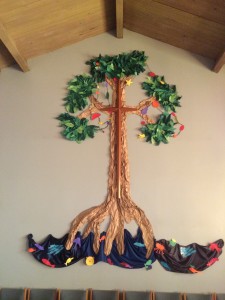“They put him to death by hanging him on a tree; but God raised him on the third day.” – Acts 10:39, 40
“The world breaks every one, and afterward, many are strong at the broken places.”
Ernest Hemingway, Farewell to Arms
Dear Easter People!
Throughout the Lenten season we have watched as the cross on the east wall of our sanctuary has gradually become the Tree of Life. God’s act of raising Jesus from the dead transforms what the world forever intends to be the tree of crucifixion into the Tree of Life! This is the new reality we celebrate on Easter. The final verdict God pronounces upon us and on all creation is not a sentence of death but rather a sentence of LIFE!
This doesn’t mean that all the woundings that life inflicts on us magically disappear on Easter—they don’t. The risen Jesus himself reveals this truth to us. In his appearance to the disciple community after his resurrection, both in Luke and in John, Jesus shows them his wounds. His hands, feet, and side still bear the marks of the nails and spear. And yet, these wounds no longer hold him captive, for they have been healed. “The world breaks every one,” wrote Hemingway, “and afterward, many are strong at the broken places.” The resurrection makes all who put their trust in the God of Jesus strong in the broken places.
Recently a colleague introduced me to a centuries-old Japanese art for fixing broken pottery. It’s called kintsugi or “golden joinery”.[1] Instead of discarding broken bowls, plates and vases, this approach to pottery (and to life) celebrates the artifact’s unique history by emphasizing the fractures and breaks instead of hiding or disguising them. The pottery is bound in its broken places with a special lacquer and then dusted with powdered gold, silver, or platinum. The result: beautiful seams of gold glint in the cracks of ceramic ware, giving it a truly unique appearance. It is often the case that this approach to repair makes the repaired piece even more beautiful than the original, revitalizing it with new life. The art of kintsugi, which dates back more than 500 years, is related to the Japanese philosophy of wabi-sabi: finding beauty in the flawed or imperfect.
Franciscan Richard Rohrer calls imperfection “the organizing principle of the entire human spiritual enterprise.” St. Francis, says Rohrer, wore patches on the outside of his habit so everyone would know what he was like on the inside. “Imperfection,” says Rohrer, “is not to be tolerated, marginalized, excused, or contextualized, or even forgiven, it is the framework in which God makes the Godself known and calls us into union.”
As we celebrate the resurrection of Christ, and God’s promise that we, too, will be raised with Christ to new life, we rejoice! For we now know that the Master Potter who formed us in the beginning will re-form us in all our broken places, repairing the fragile vessels of our lives so that they stand—even now—as emblems of beauty and grace: the broken made whole.
Alleluia!
Pastor Erik
[1] Follow this link for visual examples: http://www.mymodernmet.com/profiles/blogs/kintsugi-kintsukuroi





